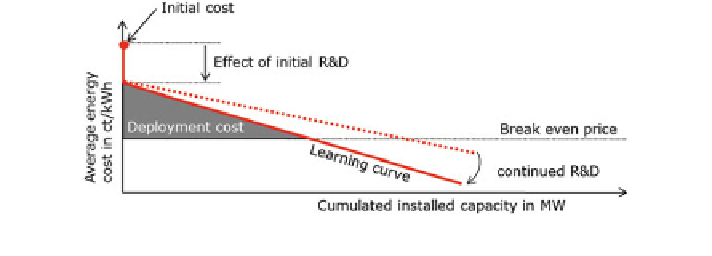Environmental Engineering Reference
In-Depth Information
Fig. 1 Schematic picture of cost reduction for renewable energy technologies
However, too high deployment subsidies can induce lock-in into a (short-term) cost
ef
cient technology preventing the development of other technology with higher
long-term potential. Additionally, large subsidies can distort market incentives in a
way that there is no net reduction in fossil energy use as the production of
renewable energy units is very energy intensive. Public R&D on the other hand can
table for private R&D.
In the US, states with transparent and openly available public R&D also attracted
signi
ll the knowledge gaps covering areas which would not pro
cantly more private R&D and venture capital in the respective sector [
8
].
The model can be extended with additional variables to account for other factors
that drive technological change.
9
Johnstone et al. (
2010
) conduct a panel regression
across 25 countries between 1978
2003 for renewable energy patents showing that
with respect to patent activity taxes, obligations and tradable certi
-
cates are the
only tools statically signi
cant. The estimations exhibit that R&D spending is more
effective for wind technologies whereas solar technologies are better supported by
price incentives. Furthermore, stronger environmental legislation leads to more
patents with heterogeneity across technologies: obligations and tradable certi
cates
are most important for wind energy, which can be explained by the cheapest form
of renewables hypothesis. According to their
ndings, solar energy on the other
hand requires more direct investment support. Nonetheless, Johnstone et al. (
2010
)
argue that in general most patent estimates are
awed due to country heterogeneity
and time trends (Fig.
1
).
Bettencourt et al. [
2
] explain the production of new energy patents in terms of
new R&D investments and expanding markets based on a Cobb-Douglas produc-
tion function. They
most technologies show greater sensitivity to market
growth than to public R&D investments though for wind the two contributions are
similar
nd that
'
.
Summing up, literature provides some evidence of (i) decreasing returns to both,
deployment and RD&D in driving innovation and (ii) a potential positive interac-
tion of the two policy measures. In addition, the price of the competing technologies
'
9
Popp [
10
] argues that the knowledge stock and the price of energy are important drivers of
innovation in renewable energy technologies.

Search WWH ::

Custom Search